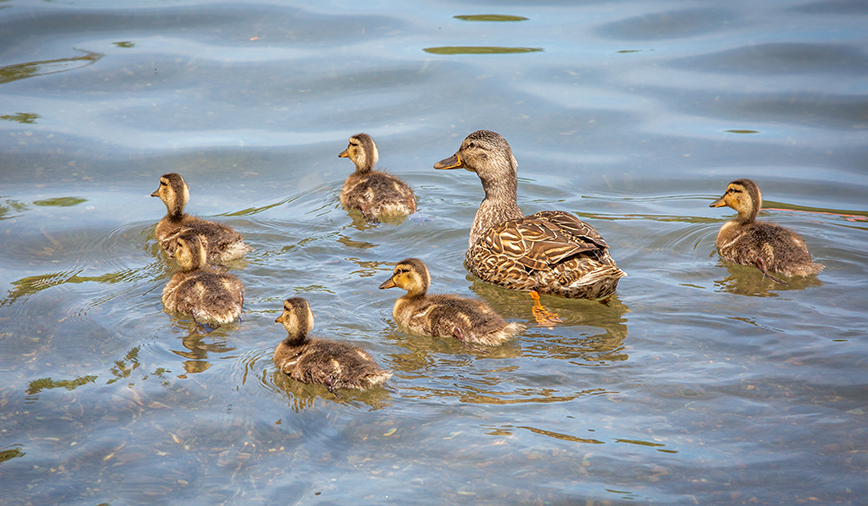411111111111111111
I couldn’t believe my eyes.
But there she was, smack dab in the middle of downtown St. Charles. A bona-fide Mother of the Year sitting with her nine half-grown offspring.
Nine!
They were near the Main Street bridge—below and a little to the south, actually—occupying a ledge by what used to be the Manor Restaurant. Mom was off to the side, and the kids were heaped in a mound beside her.
Everyone looked clean and well fed, which in itself was pretty remarkable. But the fact there were so many little ones—two more than TV’s Waltonsojn, four more than the Partridge Family—and that she raised them alone, with no help from her mate, made her achievement extraordinary indeed.
I had to stop, take a few photos and give a round of applause (discretely, lest the Pokemon Go people think I was clapping for them). I’d have given three cheers if I could have for this distinguished Anas platyrhynchos, which you might know more familiarly as the mallard duck.
Nine baby anythings would be a lot to keep track of, but keeping nine baby ducks healthy and out of harm’s way, in the middle of a downtown area, is truly amazing.
Ducklings—flightless, soft and fluffy, with absolutely zero defenses—are on the menu for just about every carnivore that frequents the Fox River. Snapping turtles. Muskellunge, or muskies. Raccoons. Mink. Herons. Hawks and owls. If you take into account the fact that those ducklings started out as duck eggs, the predator inventory grows even larger and includes coyotes, foxes and skunks.
The surrounding streetscape is rife with threats as well. Dogs and cats think nothing of batting a baby ducky around, and feral cats especially appreciate having duck for dinner. Traffic takes its toll too, as do storm drain grates with gaps that measure almost exactly one duckling wide. Litter also can be deadly, with nylon mesh and fishing line being particularly hazardous to waterfowl—babies and adults alike.
Moreover, ducks in our area face pressure from a most unlikely source: well-meaning humans.
Mallards, in fact all waterfowl in our area, lay eggs at a rate of about one per day. A female will delay incubation until the last egg is laid, keeping her nest well concealed between each “deposit.” In this way she ensures that her entire brood will hatch within a few hours of each other. The young, which are precocial, can walk around and feed themselves shortly after hatching. They still need mama’s care, but will fall in line and follow her, sometimes for blocks and over a period of days, until a water source is found.
Where these natural processes run a-fowl, ha, is when people interfere. Sometimes it’s a nest that’s found and declared abandoned. Fans of the TV sitcom Modern Family may recall, Phil Dunphy did exactly this over a series of episodes this past season. Hollywood liberties aside, “rescuing” eggs typically doesn’t work out well at all. And “rescuing” ducklings that have hatched far from water succeeds only in separating the young from their parent, the one creature that is eminently qualified to care for them.
Even if they successfully navigate this gauntlet of peril, baby ducks can still fall victim to a variety of other hazards, including weather extremes, disease and parasites—a daunting array of dangers if there ever was one.
And yet, there on the concrete shelf below the Main Street bridge, among the driftwood and assorted flotsam that makes its way into our Fox River, those nine not-so-little-ones sat in peaceful repose amid the relative safety of that ledge.
If we were to ever hold a Mother of the Year contest for wildlife, we’d find there are countless contenders. The robin that shields her young from a storm. The squirrel that totes her babies, one by one, to a safer location. The killdeer that pretends to have a broken wing, in an effort to draw attention away from her brood.
This mama mallard would face some stiff competition, for sure. There’s actually a good chance she wouldn’t win. But when all is said and done, she doesn’t need a contest or ceremony. Her achievements speak, or maybe quack, for themselves.
Pam Otto is the manager of nature programs and interpretive services at the Hickory Knolls Discovery Center, a facility of the St. Charles Park District. She can be reached at 630-513-4346 or potto@stcparks.org.

